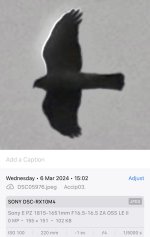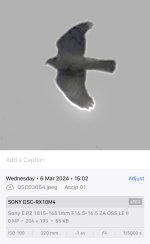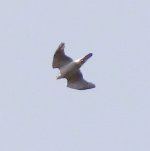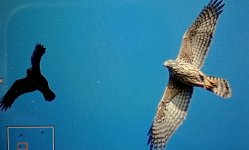kb57
Well-known member

That's fair enough and I agree with you in principle. But unless the OP is either a novice birder / unfamiliar with the species (and Ken clearly falls into neither category), his initial opinion carries significant weight, not least because he observed the bird for a longer period of time than the fraction of a second represented by the photograph.The thread has got a bit off track talking about picture numbers and the like (I know you didn't bring that up by the way).
As far as I can tell, the purpose of this sub-forum is to post a picture and ask for advice/opinions and so I'm not seeing any problem.
What were the opinions sent to you? Looking at the number of people reading this thread, there has been anything up to 40 at a time, that would suggest some people would like to know what the bird is; and 143 people have viewed your picture.
To me, the bird does look like it has a broad tail base suggesting Goshawk and a short neck suggesting Sparrowhawk. But, looking at countless pictures online it's not always clear, e.g. Sparrowhawk's don't always clearly show a narrow tail base (I suppose it depends on angle). Would you describe those secondaries in your bird as 'bulging'? I wouldn't, but again, doing some online reading tells me that it differs from Goshawk to Goshawk with birds of a certain age more likely to display those bulging secondaries.
Some people would like to know what the bird is, and the important question is: why? Maybe some of the more experienced can pass down a bit of their knowledge here.
I've used this forum for birds I'm completely unfamiliar with (Tyrannulid flycatchers) and posted a picture without any meaningful comment - generating a debate which was genuinely helpful, even if it ended up with me just being able to call it a Myiarchus sp. So no problem whatsoever with that.
I'm no Accipter expert either, and agree it would be helpful to hear more informed opinions - if in fact the species can be determined with any certainty from the only image available. FWIW, the one time I spent in the company of much more capable birders WRT long-range raptor ID (at Wykeham Forest viewpoint), they pointed out the 'cruciate' shape of distant goshawks resulting from the relatively long neck - exactly the feature that isn't shown here, and which you point out as leaning towards Sparrowhawk. And echoing what Lou just posted, I've also seen close-range displaying sparrow hawks with really fluffed up undertail coverts, so this also seems to rule out another key goshawk feature. But when experienced birders are using terms such as 'tentative', the safest option would be to settle for Accipter sp., and hope for a better view of the same bird another day.









